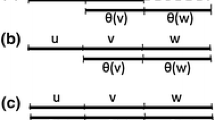Abstract
In this paper we define and investigate a binary word operation that formalizes an experimentally observed outcome of DNA computations, performed to generate a small gene library and implemented using a DNA recombination technique called Cross-pairing Polymerase Chain Reaction (XPCR). The word blending between two words \(x w y_1\) and \(y_2 w z\) that share a non-empty overlap w, results in xwz. We study closure properties of families in the Chomsky hierarchy under word blending, language equations involving this operation, and its descriptional state complexity when applied to regular languages. Interestingly, this phenomenon has been observed independently in linguistics, under the name “blend word” or “portmanteau”, and is responsible for the creation of words in the English language such as smog (smoke + fog), labradoodle (labrador + poodle), and Brangelina (Brad + Angelina).
Access this chapter
Tax calculation will be finalised at checkout
Purchases are for personal use only
Similar content being viewed by others
References
Bonizzoni, P., Ferretti, C., Mauri, G., Zizza, R.: Separating some splicing models. Inf. Process. Lett. 79(6), 255–259 (2001)
Bonizzoni, P., Felice, C.D., Zizza, R.: The structure of reflexive regular splicing languages via Schützenberger constants. Theor. Comput. Sci. 334(1), 71–98 (2005)
Brzozowski, J., Kari, L., Li, B., Szykuła, M.: State complexity of overlap assembly. arXiv preprint arXiv:1710.06000 (2017)
Carausu, A., Păun, Gh.: String intersection and short concatenation. Revue Roumaine de Mathématiques Pures et Appliquées 26(5), 713–726 (1981)
Csuhaj-Varju, E., Petre, I., Vaszil, Gy.: Self-assembly of strings and languages. Theor. Comput. Sci. 374(1), 74–81 (2007)
Domaratzki, M.: Minimality in template-guided recombination. Inf. Comput. 207(11), 1209–1220 (2009)
Enaganti, S.K., Ibarra, O.H., Kari, L., Kopecki, S.: On the overlap assembly of strings and languages. Nat. Comput. 16(1), 175–185 (2017)
Enaganti, S.K., Ibarra, O.H., Kari, L., Kopecki, S.: Further remarks on DNA overlap assembly. Inf. Comput. 253, 143–154 (2017)
Franco, G.: A polymerase based algorithm for SAT. In: Coppo, M., Lodi, E., Pinna, G.M. (eds.) ICTCS 2005. LNCS, vol. 3701, pp. 237–250. Springer, Heidelberg (2005). https://doi.org/10.1007/11560586_20
Franco, G., Bellamoli, F., Lampis, S.: Experimental analysis of XPCR-based protocols. arXiv preprint arXiv:1712.05182 (2017)
Franco, G., Giagulli, C., Laudanna, C., Manca, V.: DNA extraction by XPCR. In: Ferretti, C., Mauri, G., Zandron, C. (eds.) DNA 2004. LNCS, vol. 3384, pp. 104–112. Springer, Heidelberg (2005). https://doi.org/10.1007/11493785_9
Franco, G., Manca, V.: Algorithmic applications of XPCR. Nat. Comput. 10(2), 805–819 (2011)
Franco, G., Manca, V., Giagulli, C., Laudanna, C.: DNA recombination by XPCR. In: Carbone, A., Pierce, N.A. (eds.) DNA 2005. LNCS, vol. 3892, pp. 55–66. Springer, Heidelberg (2006). https://doi.org/10.1007/11753681_5
Golan, J.S.: The Theory of Semirings with Applications in Mathematics and Theoretical Computer Science. Addison-Wesley Longman Ltd., Reading (1992)
Goode, E., Pixton, D.: Recognizing splicing languages: syntactic monoids and simultaneous pumping. Discrete Appl. Math. 155(8), 989–1006 (2007)
Gries, S.T.: Shouldn’t it be breakfunch? A quantitative analysis of blend structure in English. Linguistics 42(3), 639–667 (2004)
Head, T.: Formal language theory and DNA: an analysis of the generative capacity of specific recombinant behaviors. Bull. Math. Biol. 49(6), 737–759 (1987)
Holzer, M., Jakobi, S.: Chop operations and expressions: descriptional complexity considerations. In: Mauri, G., Leporati, A. (eds.) DLT 2011. LNCS, vol. 6795, pp. 264–275. Springer, Heidelberg (2011). https://doi.org/10.1007/978-3-642-22321-1_23
Holzer, M., Jakobi, S.: State complexity of chop operations on unary and finite languages. In: Kutrib, M., Moreira, N., Reis, R. (eds.) DCFS 2012. LNCS, vol. 7386, pp. 169–182. Springer, Heidelberg (2012). https://doi.org/10.1007/978-3-642-31623-4_13
Holzer, M., Jakobi, S., Kutrib, M.: The chop of languages. In: Automata and Formal Languages, 13th International Conference, AFL 2011, Debrecen, pp. 197–210 (2011)
Ito, M., Lischke, G.: Generalized periodicity and primitivity for words. Math. Logic Q. 53(1), 91–106 (2007)
Kari, L.: On language equations with invertible operations. Theor. Comput. Sci. 132(1–2), 129–150 (1994)
Manca, V., Franco, G.: Computing by polymerase chain reaction. Math. Biosci. 211(2), 282–298 (2008)
Mateescu, A., Păun, Gh., Rozenberg, G., Salomaa, A.: Simple splicing systems. Discrete Appl. Math. 84(1–3), 145–163 (1998)
Mateescu, A., Salomaa, A.: Handbook of Formal Languages. Springer, New York (1997)
Pixton, D.: Splicing in abstract families of languages. Theor. Comput. Sci. 234, 135–166 (2000)
Păun, Gh.: On the splicing operation. Discrete Appl. Math. 70(1), 57–79 (1996)
Salomaa, A.: Formal Languages. Academic Press Inc., New York (1977)
Salomaa, K., Yu, S.: On the state complexity of combined operations and their estimation. Int. J. Found. Comput. Sci. 18(4), 683–698 (2007)
Acknowledgements
We thank Giuditta Franco for fruitful discussions on modelling the outcomes of various XPCR experiments.
Author information
Authors and Affiliations
Corresponding author
Editor information
Editors and Affiliations
Rights and permissions
Copyright information
© 2018 Springer International Publishing AG, part of Springer Nature
About this paper
Cite this paper
Enaganti, S.K., Kari, L., Ng, T., Wang, Z. (2018). Word Blending in Formal Languages: The Brangelina Effect. In: Stepney, S., Verlan, S. (eds) Unconventional Computation and Natural Computation. UCNC 2018. Lecture Notes in Computer Science(), vol 10867. Springer, Cham. https://doi.org/10.1007/978-3-319-92435-9_6
Download citation
DOI: https://doi.org/10.1007/978-3-319-92435-9_6
Published:
Publisher Name: Springer, Cham
Print ISBN: 978-3-319-92434-2
Online ISBN: 978-3-319-92435-9
eBook Packages: Computer ScienceComputer Science (R0)




